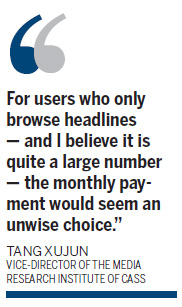Asia-Pacific
New York Times introduces paywall
By Kelly Chung Dawson and He Wei (China Daily)
Updated: 2011-03-19 08:16
 |
Large Medium Small |
New York / Shanghai - The New York Times announced yesterday that it would introduce a paywall for its website, which currently boasts the highest readership of any online news publication, with over 30 million unique visitors each month. The move was first floated over a year ago and is seen by many media experts as an inevitable first step toward creating a sustainable online news model.
|
||||
"While The Times (of London) created a paywall that completely blocked non-subscribers from the site, The New York Times' paywall is porous," said Adam Taylor, new media specialist and editor for Business Insider. "The New York Times is allowing more entry points - including, importantly, access from social media. When they get big stories, they will still get traffic."
Other sites that have created full paywalls include the Wall Street Journal and the Financial Times. But financial publications are often seen as business necessities for people in related industries, whereas The New York Times is not.
"For The New York Times to stay profitable, they would have to cut around 40 percent of their costs," Taylor said. "They could feasibly do that - but then they wouldn't be The New York Times.
"They'd have to cut down massively on foreign reporting and arts coverage, all things that are expensive but also what make The New York Times The New York Times. Instead, they're making a bet that people are willing to pay for news."
The digital fees reflect the company's confidence in the quality of its newspaper, said Li Liangrong, a professor of media studies at Shanghai-based Fudan University.

"The New York Times has its competing global influence and highest readership. The habit of reading the newspaper on a daily basis, at least in Western societies, has become a symbol of reputation and status," Li said.
Li said the paper's coverage is distinctive enough to persuade readers to pay, instead of settling for news available on hundreds of websites. That is why its business model will be hard to duplicate, Li said.
But Yu Guoming, vice-dean of the Journalism School at Renmin University of China, had reservations about the plan. He argued that while the newspaper is famous for its original and in-depth reporting, the lack of instant and professional information will be the Achilles' heel for a fee-charging model.
"In the information age, content alone no longer speaks for itself. One reason why micro blogs play a growing role in information sharing today is that they are based on a closely-connected social network," Yu said.
Given that people are used to free access to online information, the shift from "free" to "fees" indicates no substantial change of the newspaper's operation, Yu added.
A recent survey of 755 US adult Internet users by Pew Internet & American Life Project last fall underscores his concerns. Only 18 percent of the respondents had paid for a digital newspaper, magazine or article, The Associated Press reported.
Tang Xujun, vice-director of the Media Research Institute of the Chinese Academy of Social Sciences, admitted even as a loyal reader of the newspaper, he himself was far from willing to pay for reading, since "all visitors to NYTimes.com will have full access to the home page anyway. For users who only browse headlines - and I believe it is quite a large number - the monthly payment would seem an unwise choice".
Nevertheless, remaining open to new media is a strategic concession that may pay off, experts say. "It's very much intentional," said Alan Haburchak, adjunct professor of digital media at Columbia University's Graduate School of Journalism. "A significant amount of traffic on the Times' website doesn't come through the front door. If a casual reader were to click on a link and get to the website only to be immediately confronted with having to pay for a subscription, it would feel like a more crass monetizationof information."
| 分享按钮 |


